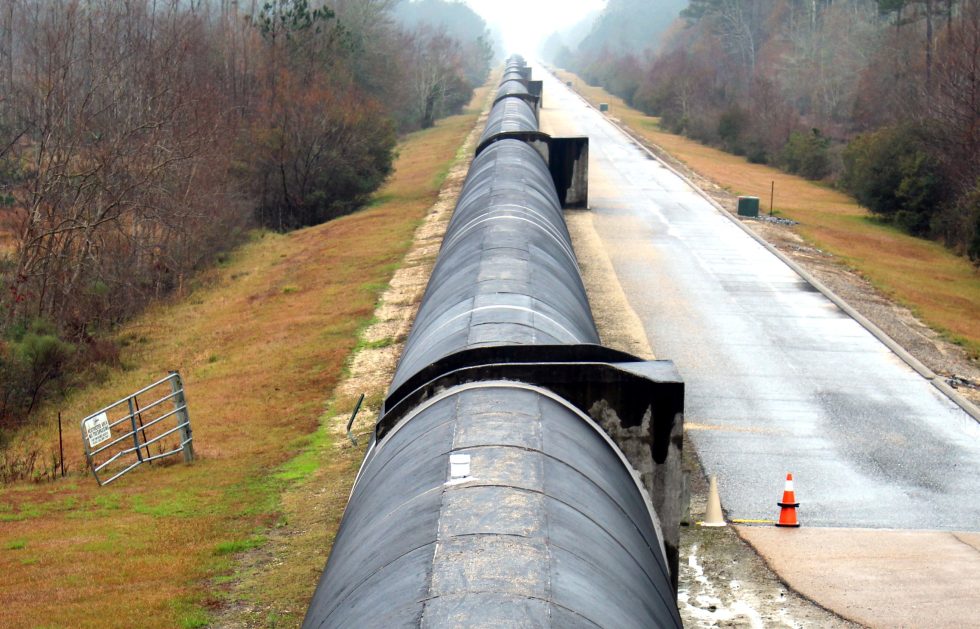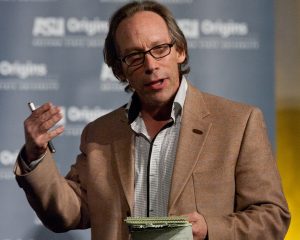
LIVINGSTON, La.—The rain began to fall as Joe Giaime and I scrambled down a lonely rise, back toward the observatory’s main building. It wasn’t so much rain as a hard mist, characteristic of the muggy weather southern Louisiana often sees in January when moisture rolls inland from the Gulf of Mexico. As gray clouds fell like a shroud over the loblolly pines all around us, Giaime mused, “Well, I guess you’ve already gathered that we’re in the middle of nowhere."
Middle of nowhere happens to be ground zero in the search for gravitational waves, which were first posited by Albert Einstein a century ago and may soon become one of the hottest fields in science. Livingston is remote in terms of geography, but as humans scan the heavens for gravitational waves this forest is practically the center of the physics universe.
Because of general relativity, we understand that large masses curve spacetime, kind of like standing in the middle of a trampoline distorts the fabric. When massive, dense objects in space accelerate, such as black holes or neutron stars, they create ripples in the fabric of spacetime. These ripples carry gravitational radiation away from the very massive objects, and the radiation then propagates through the Universe. This Louisiana observatory, the Laser Interferometer Gravitational-Wave Observatory or LIGO, exists to try to measure these subtle ripples.
The observatory has an educational center, and a few times a week yellow school buses from Baton Rouge or other nearby communities deliver hundreds of students to its front door. Giaime, a California Institute of Technology physicist who manages the lab and also a professor at Louisiana State University, says the most common question he gets is, "Why should we look for gravitational waves?" And it’s a good question, he says. The most simple answer is that it would help verify Einstein’s theory of general relativity, which in 1916 predicted the existence of curved spacetime.
Naturally there’s a deeper, better answer. The very objects that produce gravitational waves are the most energetic, wild, and interesting places in the Universe. Finding them would open new and never-before-realized windows into the universe. Genuine proof of gravitational waves could tell us about gravity at its strongest, like black holes. They could shine light on matter at its densest (ala a neutron star). And they could reveal new information about the largest explosions of the galaxy, like supernovae and the mergers of black holes and neutron stars. “These are the kinds of places we can probably only really learn about through gravitational waves,” Giaime explains.
Put simply, gravitational waves represent the key to possibly unlocking universal secrets that scientists have grappled with for hundreds of years.
-
Long before you get to the observatory, drivers are asked to slow down to 10 mph to reduce vibrations.Eric Berger
-
The observatory is located amid several logging operations. "We've had to come to peace with that," Lab Head Joe Giaime said, speaking about mitigating the noise.Eric Berger
-
The two interferometer arms emerge from the main building where its light signals are generated and processed. A large liquid nitrogen tank is to the left of "west" arm shown here.Eric Berger
-
After coming out of the main building this interferometer arm runs nearly due west for 4 km.Eric Berger
-
A big water tank in case of fires.Eric Berger
-
A building that is “not exactly an architectural triumph," Giaime said. It includes a high bay area to assemble the advanced LIGO apparatus, left, in the middle is a high performing computing cluster, and at right a science education center.Eric Berger
-
Giaime, in his office. His 6-year-old daughter's painting appears at right, although he admitted she had made this particular masterpiece when she was a good deal younger.Eric Berger
-
Logging trucks are kindly asked to keep their distance from the lab.Eric Berger
Physicists have theorized about gravitational waves for a century, and they made indirect observations long ago that provided some confirmation. But because measuring gravitational waves requires extraordinary precision, researchers have yet to directly detect them. Now after nearly four decades of planning, building, and upgrading LIGO facilities in the states of Louisiana and Washington, physicists appear to be close.
Perhaps very close.
Rumors
About two weeks before I visited the Louisiana laboratory, a well-known theoretical physicist named Lawrence Krauss fired off a tweet that reverberated around the physics community: “My earlier rumor about LIGO has been confirmed by independent sources. Stay tuned! Gravitational waves may have been discovered!! Exciting.” This was subsequently retweeted more than 3,400 times.
It did not appear to be a feint. Twice in the past 15 years senior LIGO researchers have planted false signals into the data as a drill. The purpose of such time-consuming exercises is to rehearse data analysis methods and ensure the team of researchers could actually identify a gravitational wave signal if one occurred. The last such “blind injection” exercise occurred in 2010. Krauss insisted that wasn’t the case with this particular signal, which may have dated back to September 2015.
I asked Giaime about these rumors, and his response was perfectly noncommittal. “We’re really kind of old school,” he said. “We analyze our data. If there’s anything interesting we write it up in papers. We send the papers to the journals. If and only if there’s an interesting discovery that passes muster, and it has been accepted for publication by a journal, then we blab about it. Anything before that, you’re not going to get anything out of me.”
For Giaime, the caution is understandable. He and hundreds of physicists have been at this search for a long time. Personally, Giaime has invested three decades, his entire professional life, in the search for gravitational waves.
As far back as 1972, Massachusetts Institute of Technology physicist Rainer Weiss, whom Giaime would later study under, outlined how a LIGO-like search for gravitational waves might take place. During the 1970s and 1980s physicists at MIT and the California Institute of Technology developed competing plans based upon the early theoretical work. In 1989, the two illustrious engineering universities combined forces to make a joint proposal to the National Science Foundation.
The National Science Foundation had been supporting both efforts since 1979, said Pedro Marronetti, the agency’s program director in the physics division. It welcomed a joint project, and all told the NSF has spent more than $1 billion to research, build, and operate the observatories in Livingston and Hanford, Washington, as well as support the large scientific collaborations.
“Einstein predicted the existence of gravitational waves a century ago, but it is the dedication of hundreds of scientists and engineers and the foresight and resolution of NSF staff in the past four decades that made LIGO possible today,” Marronetti told Ars.
reader comments
179